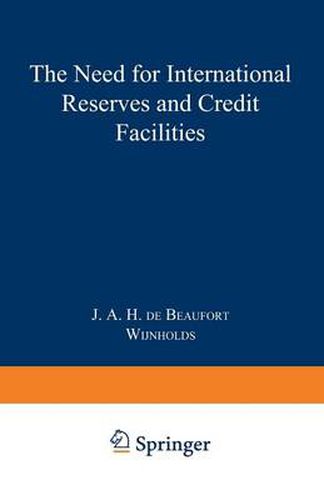Readings Newsletter
Become a Readings Member to make your shopping experience even easier.
Sign in or sign up for free!
You’re not far away from qualifying for FREE standard shipping within Australia
You’ve qualified for FREE standard shipping within Australia
The cart is loading…






This title is printed to order. This book may have been self-published. If so, we cannot guarantee the quality of the content. In the main most books will have gone through the editing process however some may not. We therefore suggest that you be aware of this before ordering this book. If in doubt check either the author or publisher’s details as we are unable to accept any returns unless they are faulty. Please contact us if you have any questions.
International monetary economics essentially deals with three problems, viz. the nature and stability of the international monetary system, the balance of payments adjustment process, and international liquidity (reserves and credit facilities). All three categories are interrelated. The exchange rate system has an important bearing on the manner in which the adjustment process functions, as well as on the need for international liquidity. The adjustment process is an important determinant of the need for international liquidity. The adequacy of international liquidity influences the working of the adjustment process. Ultimately, developments in international liquidity and in the adjustment process determine the nature and stability of the international monetary system; a sustained malfunctioning of the adjustment process - brought about by a serious imbalance in international liquidity or by other causes - will bring about a new international monetary system, either through collapse or reform of the old system. This study deals only with the problem of international liquidity. However, it touches on the two other main aspects of international monetary economics insofar as they have a bearing on international reserves and credit facilities. In the literature international liquidity is most often defined as including international reserves (gold, SDRs, foreign exchange and claims on the IMF) and international credit facilities (IMF drawing rights, EEC support arrangements and central bank multilateral and bilateral credit facilities). This definition will also be followed in this study.
$9.00 standard shipping within Australia
FREE standard shipping within Australia for orders over $100.00
Express & International shipping calculated at checkout
This title is printed to order. This book may have been self-published. If so, we cannot guarantee the quality of the content. In the main most books will have gone through the editing process however some may not. We therefore suggest that you be aware of this before ordering this book. If in doubt check either the author or publisher’s details as we are unable to accept any returns unless they are faulty. Please contact us if you have any questions.
International monetary economics essentially deals with three problems, viz. the nature and stability of the international monetary system, the balance of payments adjustment process, and international liquidity (reserves and credit facilities). All three categories are interrelated. The exchange rate system has an important bearing on the manner in which the adjustment process functions, as well as on the need for international liquidity. The adjustment process is an important determinant of the need for international liquidity. The adequacy of international liquidity influences the working of the adjustment process. Ultimately, developments in international liquidity and in the adjustment process determine the nature and stability of the international monetary system; a sustained malfunctioning of the adjustment process - brought about by a serious imbalance in international liquidity or by other causes - will bring about a new international monetary system, either through collapse or reform of the old system. This study deals only with the problem of international liquidity. However, it touches on the two other main aspects of international monetary economics insofar as they have a bearing on international reserves and credit facilities. In the literature international liquidity is most often defined as including international reserves (gold, SDRs, foreign exchange and claims on the IMF) and international credit facilities (IMF drawing rights, EEC support arrangements and central bank multilateral and bilateral credit facilities). This definition will also be followed in this study.